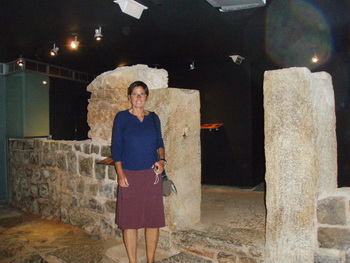
May
2008
Part Three
Almerimar to Cartagena
| |
| HOME |
| About Tenaya |
| About Us |
| Latest Update |
| Logs from Current Year |
| Logs from Previous Years |
| Katie's View |
| Route Map |
| Links |
| Contact Us |
![]()
May 14, 2008
The weather was perfect to begin our 110 mile sail from Almerimar to Cartagena. The trip should take 22 hours so a noon departure was the plan. At 11 o'clock Jim had a conversation with Marco, the resident live-aboard radio expert. Marco is adamant that an AIS receiver should have its own antenna not be shared with the VHF. He suggested we install one as it could be done in an hour. So off went Jim to the chandlery for parts. The antenna needed a piece welded on so I volunteered to fetch it while Jim and Marco pulled off the panel and began the wiring. I returned to a horrible smell in the main saloon. The wrong wires were touched and we'd had a small fire in the wiring panel that destroyed only one set of wires, those to the AIS. I returned to the store for replacement wire as Jim and Marco tried to mount the antenna to our radar pole. Dismounting the pole and running the wire took quite a while and with Bob's help they sorted it out.
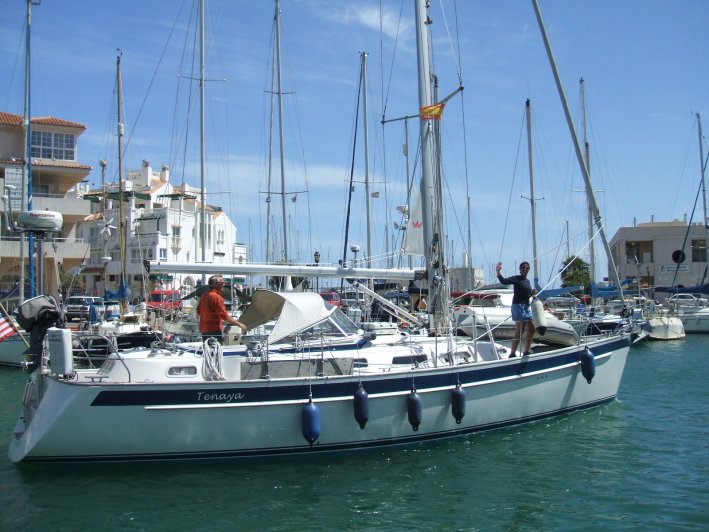
Bob and Liz took our picture as we left Almerimar
We cast off the dock lines at 4 pm in 15 knots of wind. Not uneventfully I might add. Once free we drifted quickly to leeward. Our keel caught on the neighboring boat's mooring line and stopped us dead. With Jim manoevering at the helm and my instructions and fending off we were soon on our way with no harm done. After stopping at the marina office to settle up we were on our way. As we left the safety of the harbor the winds had increased to over 20 knots. We were finally on our way!
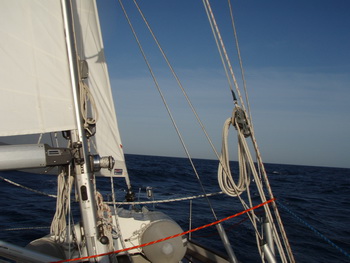
The sail east to Cabo de Gata was fantastic with the wind between 20 and 25 knots from the west. Normally these are ideal conditions but after not sailing for 6 months we were a little anxious but still thrilled. Nothing like jumping in with both feet! Tenaya seemed happy to be moving again. With a clean bottom with new paint she sailed at speeds of more than 8 knots for 12 hours. It was exhillarating and a great way to start off the season.

We were often sailing at over 9 knots, sometimes topping 10. Jim took videos to prove we weren't just surfing.
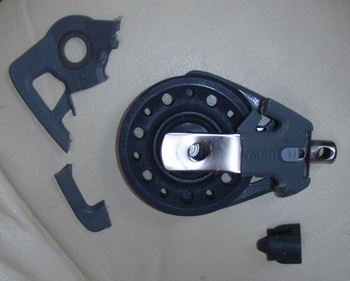
Sometimes you just do something really stupid
Tenaya has electric winches. They were an option our sales agent suggested we buy. Our plan was to use them rarely and normally grind for exercise. In reality we use them all the time. One of the biggest problems with electric winches is that they are very strong and because you aren't grinding you don't know how much they are straining. Around 8 pm the 25 knot wind backed and was on our beam so Jim wanted to pull in the main a bit. He put the sheet around the electric winch and pushed the button. Since we had a preventer on the boom to protect us from an accidential gybe it did its job and kept the boom from moving. Something had to give. The block on the traveller blew apart and the noise scared the daylights out of us.

Jim was able to jury rig a snatch block on the traveller
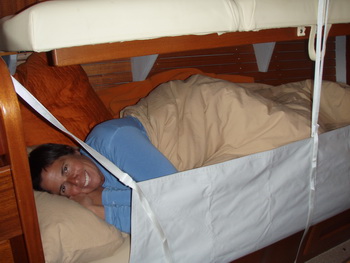
Katie settling down for a nap
About 4:00 am the wind died and Jim turned on the engine. Finally I was able to sleep for a couple of hours. I awoke refreshed and able to give Jim a chance to sleep. It was so peaceful and in such contrast to the spirited motions of the previous day and night. I like to hand steer while we're sailing but am happy to let the autopilot take control when motoring. Long periods went by without seeing other ships. At one point I went below for a moment and when I returned to the cockpit a small, dilapidated, white dingy was passing by with only a seagull on board. Whoops, I'd missed that. Glad we didn't hit it. That would not have been a nice way for Jim to wake up.
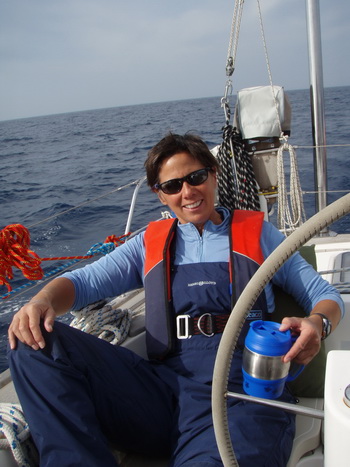
A leisurely watch after an exciting start to our trip
After the close call with the dingy I kept a keen lookout. At one point I saw a strange looking thing on the water. Out came the binoculars. It was a submarine. Jim had just awaken and was doing that morning stuff in the head. I was excited for him to see the sub but unfortunately it disappeared below before he came up into the cockpit. I'm not sure he believed me until later that day one came into the harbor.

Maybe this was the same sub Katie saw out at sea
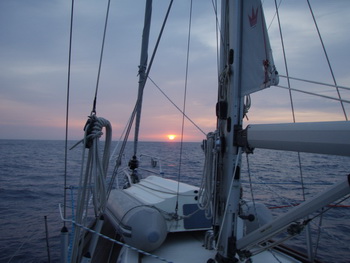
Sunrise on May 15 about 40 miles from Cartagena
About 30 miles before Cartagena we were hailed on the VHF by the Spanish military. He asked us to alter course to due north. From the Navtex we knew the coordinates of naval exercises taking place and were careful to plot our course around it. Guess they wanted a bigger buffer zone. We complied. When it was time to alter course to reach Cartagena we wondered if it would be all right with the navy. Jim figured we were far enough away and changed course. Moments later a voice on the radio hailed the sailing yacht Tenaya. Before picking up the receiver Jim put us back on course 360. The voice was Paul from Pond Life, a Moody 42 that left Almerimar a couple of days before us. Not who Jim was expecting! After a quick update he signed off and altered course towards Cartagena.
We arrived at 4:15 in the afternoon. Paul, Phillipa and young Oscar aboard Pond Life arrived shortly thereafter and berthed next to us. Another couple from Almerimar, Tim and Caroline on Cygne Magique, was already berthed on the same pontoon. We spent two pleasant days in a town that was much more interesting than the guide books indicated.
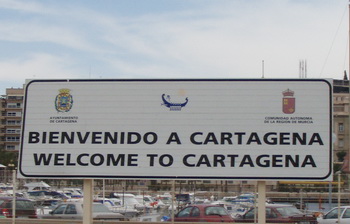
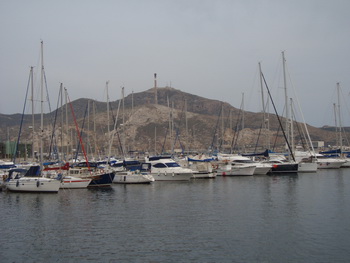
The marina at Cartagena
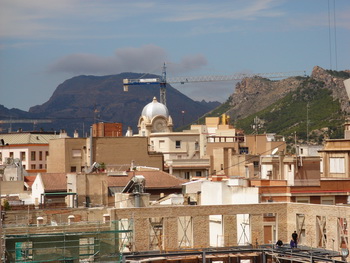
A view of the rooftops in the old part of town
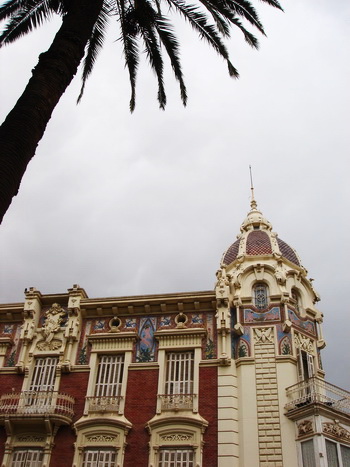
.
The natural harbor of Cartagena has been protecting ships since ancient times. The Phoenicians traded in the area and lived in small colonies dotting the coast as early as the 12th century BC. Hamilcar Barca, Carthage's most distinguished general, came to this spot on the Iberian Penninsula in 237 BC bringing along his young son, Hannibal. In just 8 years he built the infrastructure of a prosperous state and a sizable army to defend it. This became the permanent capital of Carthaginian Spain. The Romans called it Carthago Nova and we call it Cartagena. It was from Cartagena that Hannibal began his military expedition over the Alps to Rome. Imagine moving 40,000 men and 37 elephants! Historians are still trying to find his exact route.
The Romans took Cartagena in 219 BC. According to legend St. James sailed from Palestine to Cartagena in 4 days where he brought Christianity to Spain in 36 AD. He moved on and was eventually buried at Santigo de Compostela. The Byzantines followed the Romans and the Barbarians (Visigoths) invaded in the 5th century and ruled to the 7th century AD. In 711 AD the Moors and Berbers took the city. The Spanish claimed it in the 13th century. Now, in 2008, it is the most important naval base in Spain.
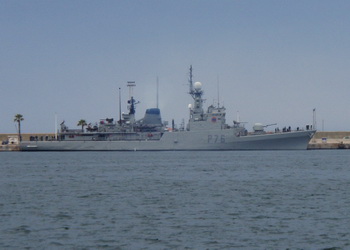
Spanish navy ship returning to port
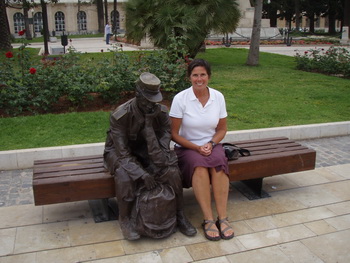
There are monuments and statues honoring Spanish servicemen around the harbor.
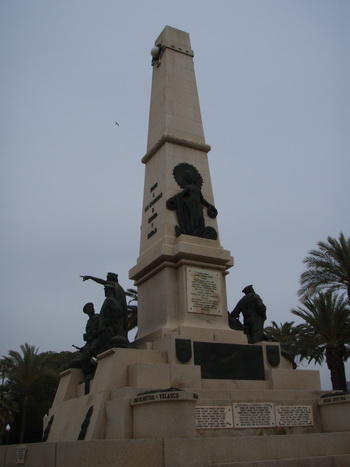
This statue honors those killed in the Spanish American War in 1898. The Spanish call it the Cuban War against us.
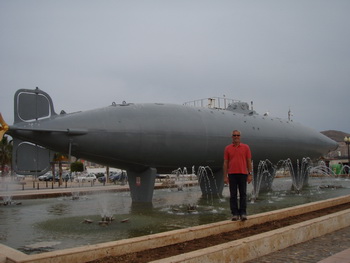
This Pioneer Submarine was designed by local inventor Isaac Peral in 1888.
Hills ring the city. Narrow medieval streets around the port area are filled with lovely architecture and character. Beneath the streets are thousands of years of ancient architecture that is just being unearthed. On Friday we wandered the streets of the old town and discovered several newly excavated sites. All in all it was a very interesting and enjoyable visit.
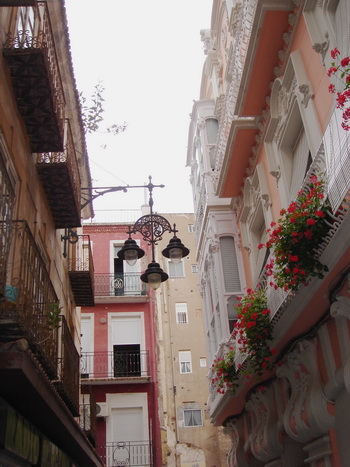
A pretty street scene in the old part of town
Spain has prospered a great deal in the last several years. Lots of new building has occured and more is underway. While building a new ampitheter the remains of another built during the Roman times was unearthed in nearly the same location.
Further investigation revealed that portions of the old Roman Theatre were used by the Byzantines to construct a citadel on the site.
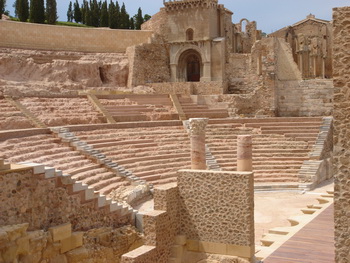
This ancient Roman theater has only recently been discovered.
Across the street from the Roman theater is the Municipal Exhibition Hall. Descending the stairs from the art exhibit reveals an excavation site with mosaic floors, walls, foundations and steps from The Roman era through the Byzantine era. This fascinating display was discovered in 1983 before the Roman Theatre. a pathway allows visitors to walk all around the fascinating site.
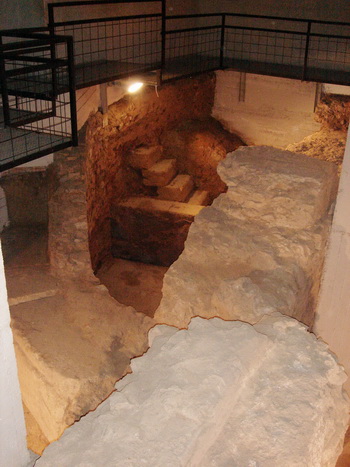
Walls and stairs from the Byzantine period
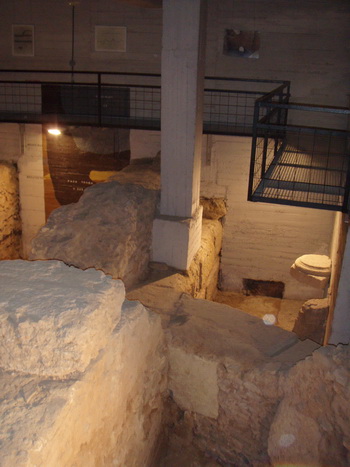
The ancient foundation is still useful for the new building.
In another underground museum we saw the The Casa de la Fortuna, a complete Roman dwelling dating back to the end of the 1st century BC. Most likely it was owned by a wealthy person as the masses lived in blocks of multi-story buildings. Impressive mosaics and fresco murals decorate the floors and walls. The word Fortuna was inlaid on the ground, hence the name. This dwelling was discovered in the year 2000. More recently another has been discovered next door and excavation is in progress.
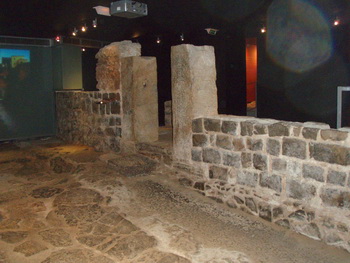
This picture shows the entrance of the house, elevated two steps above the street. The street is paved with irregular slabs of grey limestone with sandstone sidewalks on each side. Beneath the street lie a sophiscated drainage and canal system.
After an enjoyable walk around the old town we joined the crew of Pond Life aboard Cygne Magique for cocktails (and water). The following day we all set off for points north. We hope to meet again at an anchorage in Formentera.
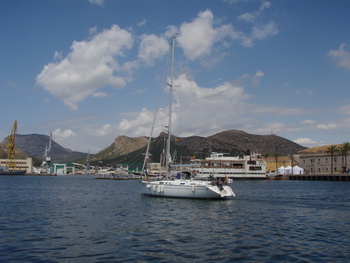
Pond Life leaving Cartagena
Watch Video - Sailing from Almerimar to Calpe
.